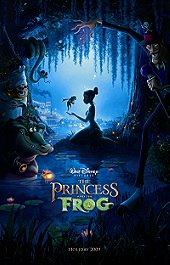It was five long years between Home on the Range’s hand-drawn animation and The Princess and the Frog’s return to the format. In fact, it feels like a long-lost relic from the Disney Renaissance, that second golden age which brought about neo-classics like Beauty and the Beast and The Little Mermaid. If everything in The Princess and the Frog feels slightly formulaic, at least it’s an exceptionally well-done piece of formula, and, frankly, in my eyes, a welcome and missed one. Hand-drawn animation, how do I miss you as each year goes by.
What The Princess and the Frog has going for it in spades, in stark contrast to the gag-a-minute brain-dead films of DreamWorks, is a solid story structure, characters who clearly articulate their wants and needs, warm and lovely animation, and a score that maybe lacks in instant classics but makes up for with authenticity of time and place. Although the few musical numbers which burst out from the rest of the pack are a one-two punch of “Almost There” and “Friends on the Other Side.” Both of them explode with color, various shapes, and artistic experiments in contrast to the glossy and clean animation of the rest of the film. “Friends,” in particular, is great for its Cab Calloway-meets-Faustus spice. The only other song which linger in the mind is the gospel-tinged “Dig a Little Deeper” with voodoo queen/fairy godmother Mama Odie, a charming and memorable minor player.
Like any of the Renaissance era princess, our latest heroine, Tiana, isn’t in dire need of a personality, or even necessarily a prince. Tiana believes in hard work, setting goals, and making her life-long dream a reality. She’s a little Type A, and could use some fun and adventure in her life. She learns to soften her Type A after accidentally turning into a frog, and finds a prince to add some fun and color to her life. And it must be said, Prince Naveen is, without a doubt in my mind, the handsomest prince that Disney has ever come up with, and kudos to Disney for reflecting our modern culture’s tendency towards interracial marriage and giving their latest princess a racially ambiguous prince to live out her happily ever after with.
The story is, like many of their best features, a retelling of an old Grimm Brothers fairy tale. A prince by magical circumstances becomes a frog and seeks a princess to break the spell. That’s about all of the connections that this has with the original fairy tale. Gone are the golden ball, the spoiled princess, and that pesky, briefly hinted at sex and nudity. In their place are New Orleans culture and music. I think it’s a more than fair trade.
Orbiting around the two romantic leads are a series of mostly enjoyable supporting players. My personal favorites are the aforementioned voodoo queen Mama Odie, the villainous Dr. Facilier, a neurotic jazz-trumpet playing alligator named Louis, and Tiana’s childhood friend, Lottie, a southern debutante with a flair for the dramatic. Not every single digression is golden, a brief detour with some hillbilly stereotypes is a bit of dead weight. But The Princess and the Frog has a higher rate of hitting its various check-boxes than missing them.
I don’t know if it’s a new masterpiece, but it’s certainly a solidly made and highly enjoyable film from the Disney canon. If it’s not top-shelf, then, damn, it’s got to be a solid member of the B-team. Shame this film didn’t perform better at the box office. Rumor has it that it’s underperformance convinced Disney to abandon hand-drawn animation and remove girl-centric titles from future films. Guess that explains thatRapunzel turned into Tangled, and The Snow Queen into Frozen. The Princess and the Frog is the Disney formula operating at top speed, providing the kind of charm, wit, and pleasing visuals that only the House of Mouse can.
 Login
Login